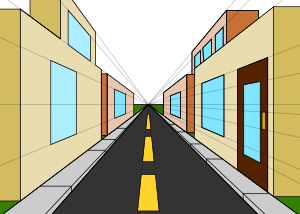Vanishing point facts for kids
Imagine looking down a long, straight road or a railroad track. Even though the sides are parallel, they seem to get closer and closer together in the distance. They appear to meet at a single point far away. In art, this special spot is called a vanishing point. It's a key part of creating perspective in drawings and paintings.
Perspective helps artists make flat pictures look like they have depth and space. It makes objects seem closer or farther away, just like in real life. The vanishing point is where lines that are actually parallel in real life appear to come together on the canvas.
Contents
What is a Vanishing Point?
A vanishing point is a specific spot on the horizon line in a drawing. It's where all lines that are parallel to each other in real life seem to meet. Think of train tracks or the edges of a long building. Even though they never meet in reality, they look like they do in a picture.
This artistic trick helps create the illusion of three dimensions on a two-dimensional surface. It makes scenes look more realistic and deep. Artists use vanishing points to guide your eye through the artwork.
How Vanishing Points Work
Artists use different types of vanishing points depending on the look they want to achieve. The most common types are one-point, two-point, and three-point perspective. Each type uses one or more vanishing points to create different effects of depth.
One-Point Perspective
In one-point perspective, all parallel lines that go away from the viewer meet at a single vanishing point. This point is usually right in the middle of the drawing. It's often used when you are looking straight down a road or into a room.
This method is great for showing depth directly in front of you. It makes objects appear to recede into the distance. Many artists use it for simple, clear scenes.
Two-Point Perspective
Two-point perspective uses two vanishing points on the horizon line. These points are usually on opposite sides of the drawing. This type of perspective is used when you are looking at an object from an angle, like the corner of a building.
The lines going away from you will go towards one of the two vanishing points. This creates a more dynamic and realistic view of objects. It helps show the sides of things, not just the front.
Three-Point Perspective
Three-point perspective adds a third vanishing point. This third point is either above or below the horizon line. It's used to show extreme height or depth, like looking up at a very tall skyscraper or down from a high cliff.
This method makes objects look very tall or very deep. It adds another layer of realism, showing how things appear when viewed from very high or very low angles.
Vanishing Points in Art History
The idea of vanishing points and perspective became very important during the Renaissance period in Europe. Artists like Filippo Brunelleschi and Leon Battista Alberti studied how to create realistic depth. They developed rules for using perspective in art.
One famous example is the work of Pietro Perugino. His fresco Delivery of the Keys in the Sistine Chapel shows amazing use of perspective. He used a vanishing point to make the buildings and figures look incredibly real and deep. This helped bring new artistic ideas to Rome.
Using vanishing points allowed artists to create paintings that felt like windows into another world. It changed how art was made and viewed forever.
Images for kids
-
Pietro Perugino's use of perspective in the Delivery of the Keys fresco at the Sistine Chapel (1481–82) helped bring the Renaissance to Rome.
See also
 In Spanish: Punto de fuga para niños
In Spanish: Punto de fuga para niños






